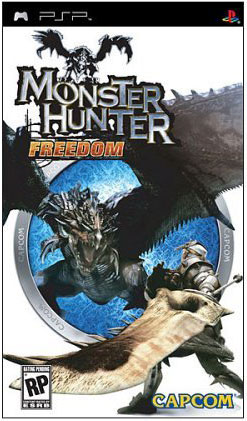Monster Hunter Freedom
Topic: Software
 From HandWiki - Reading time: 4 min
From HandWiki - Reading time: 4 min
| Monster Hunter Freedom | |
|---|---|
 North American box art | |
| Developer(s) | Capcom Production Studio 1 |
| Publisher(s) | Capcom |
| Director(s) | Yasunori Ichinose |
| Producer(s) | Tsuyoshi Tanaka |
| Designer(s) | Katsuhiro Eguchi Yuji Matsumoto Kennsuke Imamura Yōichirō Ikeda Shintaro Kojima Eri Sawada Goro Terada |
| Composer(s) | Masato Kohda Yuko Komiyama Akihiko Narita |
| Series | Monster Hunter |
| Platform(s) | PlayStation Portable |
| Release | |
| Genre(s) | Action role-playing game |
| Mode(s) | Single player, multiplayer |
Monster Hunter Freedom[lower-alpha 1] is an action role-playing video game developed and published by Capcom for the PlayStation Portable. The first handheld installment in the Monster Hunter franchise, the game is an enhanced port of Monster Hunter G, rebalanced to allow for easier solo quest completion and game progression.
Gameplay
Just like its predecessors, Monster Hunter and Monster Hunter G, this game revolves around the player completing quests and gathering materials to upgrade their equipment in order to advance. The more rare the items and equipment, the stronger the main physical aspects of the character will be. Unlike other hack 'n' slash games, this game requires planning and skill in order to overcome large monsters instead of brute force. There are many weapons which the hunter can use to bring down the monsters, these are Sword and Shield, Great Swords, Dual Blades, Hammers, Lances, Light Bowguns and Heavy Bowguns. Each requires a variety of items to create which are acquired by completing quests, and collecting the spoils carved from monsters or found on the ground.
Singleplayer
In this mode the player can do village elder quests, and enter the Offline Gathering Hall to do guild quests by themselves, and buy items to aid in the completion of the quest. The player can also tend to a farm to harvest useful items.
Multiplayer
If players enter the Online Gathering Hall they can go on quests with other players via the PSP's adhoc. They can exchange guild cards which keep track of the characters stats. They can also go on treasure hunting quests. While the characters are waiting for others to join their quests there is a table they can sit at. While sitting at the table, you can push the different directions on the directional arrows to perform various animations such as swinging their beer mug, or passing out from drunkenness. Players can also use third party software to connect with other players over the internet to play with each other wirelessly.
Classes
Hunter Ranks
There are a number of Hunter ranks, given numerical values from HR1 to HR5. As the player's Hunter rank increases, they will get access to more difficult monsters, and in turn more and better items and weapons.
G-Rank
G-Rank is a new addition to Monster Hunter Freedom. These quests are taken straight from Monster Hunter G, which was unreleased in the U.S and Europe, and present a much more difficult challenge for hunters. In return for this, hunters receive better rewards for completing the quest as well as access to some of the stronger variations of previously encountered monsters, known as "sub-species". There are also certain monsters that can only be encountered in this particular rank.
Reception
| Reception | ||||||||||||||||||||||||||||||||||||||
|---|---|---|---|---|---|---|---|---|---|---|---|---|---|---|---|---|---|---|---|---|---|---|---|---|---|---|---|---|---|---|---|---|---|---|---|---|---|---|
| ||||||||||||||||||||||||||||||||||||||
The game received "average reviews" according to video game review aggregator Metacritic.[1] In Japan, Famitsu gave it a score of two nines and two eights, for a total of 34 out of 40.[4]
Notes
References
- ↑ 1.0 1.1 "Monster Hunter Freedom for PSP Reviews". https://www.metacritic.com/game/monster-hunter-freedom/critic-reviews/?platform=psp. Retrieved December 24, 2015.
- ↑ EGM staff (June 2006). "Monster Hunter Freedom". Electronic Gaming Monthly (204): 118.
- ↑ Whitehead, Dan (May 8, 2006). "Monster Hunter Freedom". http://www.eurogamer.net/articles/r_monsterhunterfreedom_psp. Retrieved December 25, 2015.
- ↑ 4.0 4.1 Gantayat, Anoop (December 7, 2005). "Now Playing in Japan (Page 3)". http://www.ign.com/articles/2005/12/07/now-playing-in-japan-17?page=3. Retrieved December 25, 2015.
- ↑ "Monster Hunter Freedom". Game Informer (158): 119. June 2006.
- ↑ Tenacious Moses (May 31, 2006). "Review: Monster Hunter Freedom". GamePro. Archived from the original on June 3, 2006. https://web.archive.org/web/20060603042516/http://www.gamepro.com/sony/psp/games/reviews/57928.shtml. Retrieved December 25, 2015.
- ↑ Reilly, Mike (June 5, 2006). "Monster Hunter: Freedom Review". Game Revolution. http://www.gamerevolution.com/review/monster-hunter-freedom. Retrieved December 25, 2015.
- ↑ Davis, Ryan (May 23, 2006). "Monster Hunter Freedom Review". http://www.gamespot.com/reviews/monster-hunter-freedom-review/1900-6151713/. Retrieved December 25, 2015.
- ↑ Speer, Justin (May 31, 2006). "GameSpy: Monster Hunter Freedom". GameSpy. http://psp.gamespy.com/playstation-portable/monster-hunter/710805p1.html. Retrieved December 25, 2015.
- ↑ "Monster Hunter Freedom Review". GameTrailers. June 18, 2006. Archived from the original on August 7, 2007. https://web.archive.org/web/20070807172733/http://www.gametrailers.com/gamepage.php?id=2431. Retrieved December 25, 2015.
- ↑ Valentino, Nick (June 4, 2006). "Monster Hunter Freedom - PSP - Review". GameZone. Archived from the original on October 6, 2008. https://web.archive.org/web/20081006185507/http://psp.gamezone.com/gzreviews/r28261.htm. Retrieved December 25, 2015.
- ↑ Castro, Juan (May 30, 2006). "Monster Hunter Freedom". http://www.ign.com/articles/2006/05/31/monster-hunter-freedom. Retrieved December 25, 2015.
- ↑ "Monster Hunter Freedom". Official U.S. PlayStation Magazine: 100. June 2006.
- ↑ Huschka, Ryan (July 21, 2006). "Monster Hunter Freedom". Detroit Free Press. http://www.freep.com/apps/pbcs.dll/article?AID=/20060723/ENT06/607230501/1044. Retrieved December 25, 2015.
- ↑ Hill, Jason (July 14, 2006). "Monster Hunter Freedom". The Sydney Morning Herald. http://www.smh.com.au/news/game-reviews/monster-hunter-freedom/2006/07/12/1152383751646.html. Retrieved December 25, 2015.
External links
- Official Monster Hunter website[yes|permanent dead link|dead link}}]
- Monster Hunter Freedom at MobyGames
Template:Monster Hunter Series
 |
 KSF
KSF